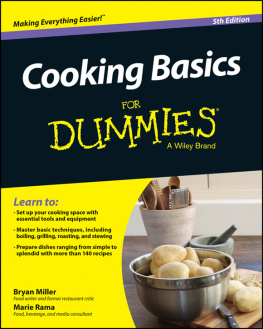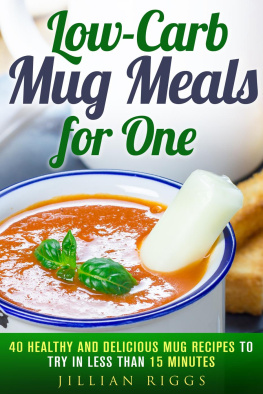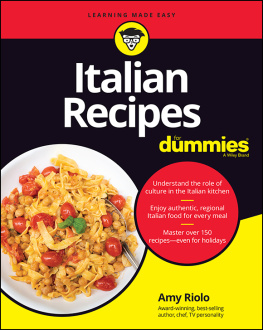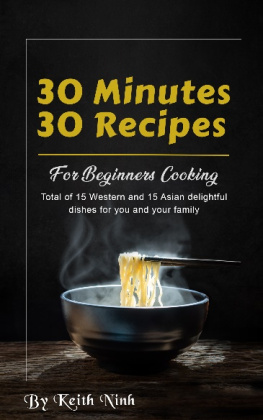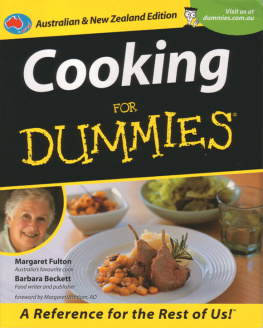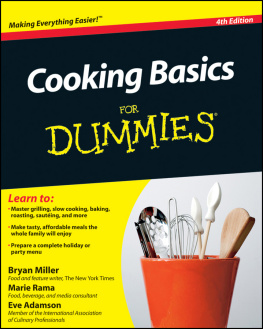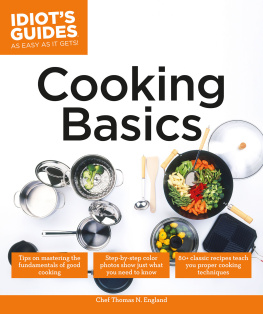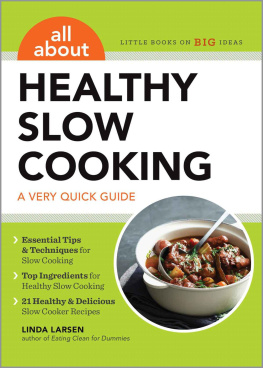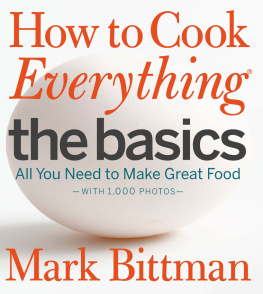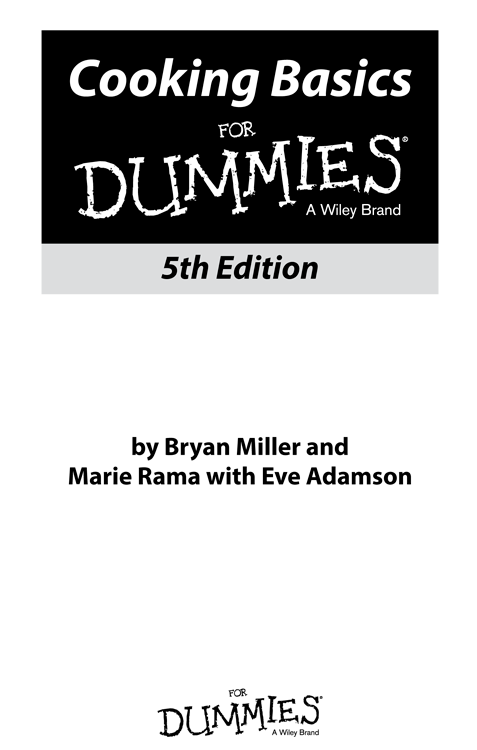
Cooking Basics For Dummies, 5th Edition
Published by: John Wiley & Sons, Inc.
111 River Street
Hoboken, NJ 07030-5774
www.wiley.com
Copyright 2015 by John Wiley & Sons, Inc., Hoboken, New Jersey
Published simultaneously in Canada
No part of this publication may be reproduced, stored in a retrieval system or transmitted in any form or by any means, electronic, mechanical, photocopying, recording, scanning or otherwise, except as permitted under Sections 107 or 108 of the 1976 United States Copyright Act, without the prior written permission of the Publisher. Requests to the Publisher for permission should be addressed to the Permissions Department, John Wiley & Sons, Inc., 111 River Street, Hoboken, NJ 07030, (201) 748-6011, fax (201) 748-6008, or online at http://www.wiley.com/go/permissions .
Trademarks: Wiley, For Dummies, the Dummies Man logo, Dummies.com, Making Everything Easier, and related trade dress are trademarks or registered trademarks of John Wiley & Sons, Inc., and may not be used without written permission. All other trademarks are the property of their respective owners. John Wiley & Sons, Inc., is not associated with any product or vendor mentioned in this book.
LIMIT OF LIABILITY/DISCLAIMER OF WARRANTY : WHILE THE PUBLISHER AND AUTHOR HAVE USED THEIR BEST EFFORTS IN PREPARING THIS BOOK, THEY MAKE NO REPRESENTATIONS OR WARRANTIES WITH RESPECT TO THE ACCURACY OR COMPLETENESS OF THE CONTENTS OF THIS BOOK AND SPECIFICALLY DISCLAIM ANY IMPLIED WARRANTIES OF MERCHANTABILITY OR FITNESS FOR A PARTICULAR PURPOSE. NO WARRANTY MAY BE CREATED OR EXTENDED BY SALES REPRESENTATIVES OR WRITTEN SALES MATERIALS. THE ADVICE AND STRATEGIES CONTAINED HEREIN MAY NOT BE SUITABLE FOR YOUR SITUATION. YOU SHOULD CONSULT WITH A PROFESSIONAL WHERE APPROPRIATE. NEITHER THE PUBLISHER NOR THE AUTHOR SHALL BE LIABLE FOR DAMAGES ARISING HEREFROM.
For general information on our other products and services, please contact our Customer Care Department within the U.S. at 877-762-2974, outside the U.S. at 317-572-3993, or fax 317-572-4002. For technical support, please visit www.wiley.com/techsupport .
Wiley publishes in a variety of print and electronic formats and by print-on-demand. Some material included with standard print versions of this book may not be included in e-books or in print-on-demand. If this book refers to media such as a CD or DVD that is not included in the version you purchased, you may download this material at http://booksupport.wiley.com . For more information about Wiley products, visit www.wiley.com .
Library of Congress Control Number: 2014940489
ISBN 978-1-118-92231-6 (pbk); ISBN 978-1-118-92232-3 (ebk); ISBN 978-1-118-92233-0 (ebk)
Manufactured in the United States of America
10 9 8 7 6 5 4 3 2 1
Appendix A
Glossary of 100 (Plus) Common Cooking Terms
Cooking and recipe writing have their own distinct language. Before you roast a chicken, for example, you need to know what trussing means. To make a souffl that rises above the rim of the dish, you need to understand whipping and folding egg whites. This appendix gives you a list of basic terms. Most of them are thoroughly described elsewhere in the book.
al dente: An Italian phrase meaning to the tooth that describes the tender but still firm texture of perfectly cooked pasta. (See Chapter for pasta recipes.)
au gratin: A dish, usually topped with buttered breadcrumbs, grated cheese, or both that has been browned in the oven or under the broiler.
bain-marie: A container partially filled with hot water that holds a smaller pan for gentle cooking.
barbecue: Any food cooked on a charcoal or gas grill over an indirect fire (as opposed to grilling, which occurs directly over the fire). Also refers to the process of cooking foods in a pit or on a spit for a long time, or is a descriptive term for the particular spicy tomato-based sauce used to baste grilled meat.
baste: To add flavor and moisture by brushing food with pan drippings, fat, or a seasoned liquid as it cooks.
batter: An uncooked, semiliquid mixture usually containing beaten eggs, flour, liquid, and a leavening ingredient, such as baking soda or baking powder, that makes the batter rise when cooked.
beat: To mix ingredients briskly in a circular motion so they become smooth and creamy. A hundred hand-beaten strokes generally equal one minute with an electric mixer, if youre the type who counts these things. (See Chapter for information about beating egg whites.)
bind: To bring together a liquid mixture, such as a sauce, with a thickening ingredient, such as cream or butter.
blanch: To plunge vegetables or fruits into boiling water for a short time to loosen their skin or preserve their color (see Chapter ).
blend: To mix or combine two or more ingredients with a spoon, whisk, spatula, or electric mixer.
boil: To bring the temperature of a liquid to 212 degrees for water at sea level, causing bubbles to break at the surface (see Chapter ).
bone (or debone): To remove the bones from meat, fish, or poultry.
bouquet garni: A package of mixed herbs (often tied in cheesecloth) thats used to season stocks, soups, and stews to impart flavor. A typical combination is parsley, thyme, and bay leaf.
braise: To brown meat or vegetables in fat and then cook, covered, in a small quantity of liquid over low heat, usually for a long time. The long, slow cooking both tenderizes and flavors the food, especially tough cuts of meat. Braising can take place either on the stovetop or in the oven. (See Chapter for braising and stewing recipes.)
bread: To coat a piece of food with crackers or breadcrumbs to seal in moisture and give it a crisp crust. The piece of fish, poultry, meat, or vegetable is usually first dipped into a liquid, such as beaten egg or milk, to make the crumbs adhere.
broil: To cook food under a hot oven coil, as opposed to grilling, in which the heat is underneath (see Chapter ).
brown: To cook food briefly over high heat, usually in fat and on top of the stove, to impart a rich brown color to its skin or surface. Food also may be browned in a very hot oven or under the broiler.
brush: To coat the surface of food with a liquid ingredient, such as melted butter, egg, or fruit glaze.
butterfly: To split food down the center (removing bones if necessary), leaving the two halves joined at the seam so the food opens flat to resemble a butterfly.
caramelize: To heat sugar until it melts into a liquid, syrupy state that ranges from golden to dark brown in color (320 degrees to 350 degrees on a candy thermometer). Also, to cook onions and other vegetables until they become soft and brown (the sugars they contain caramelize).
chill: To put food in a cool place, typically the refrigerator, to bring it to a cold (but not frozen) state.
chop: To cut food into small pieces by using a knife or food processor.
clarify: To make a cloudy liquid clear by removing the impurities. For example, you can clarify a stock or broth by simmering raw egg whites or eggshells in it for 10 to 15 minutes to attract impurities. You then very gently strain the liquid through a sieve lined with cheesecloth.
compound butter: Butter that has been flavored with herbs or spices.
confectioners sugar: A fine powdered sugar cut with cornstarch thats used for cake icings or to powder cakes and cookies. Also called powdered sugar.
Next page
